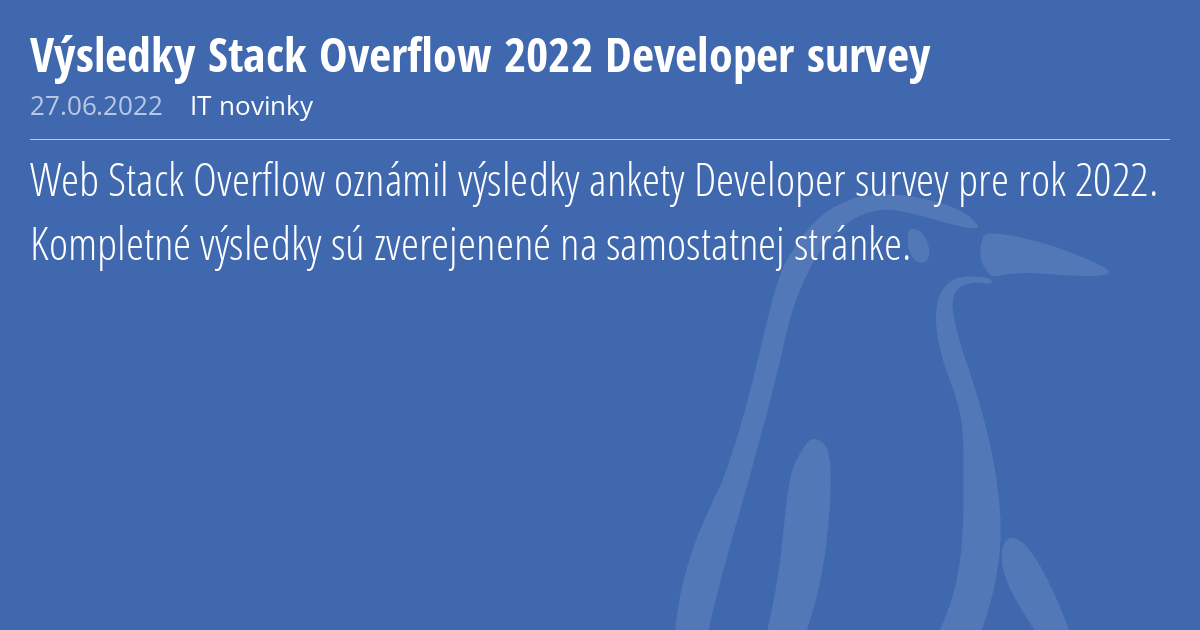
🔗 IT Operations Trends: Back-end, DevOps and Traditional Ops This actually surprised me, I expected the ratio of front-end to back-end engineers to be closer throughout the years.

The ratio of front-end/back-end engineers has stayed fairly consistent, with there being slightly less than twice as many back-end engineers than front-end engineers. Smaller companies typically require more generalists, but now I’m just guessing. Keep in mind, this also might be that there have been more small to mid-sized companies over the years. More and more are doubling as full-stack engineers. It seems reasonable to conclude that the trend for the last decade has been that there are a shrinking percentage of developers who do only front-end work or only back-end work. It’s important to note that in 2017/2018 the survey changed drastically, which is why we see a big change in the numbers.
#STACKOVERFLOW 2022 SURVEY FULL#
The trend of “more full stack, less specialization” continues through the entire ten years of data. In 2013 the ratio of “front-end” developers to “full stack” developers was 15/85, while the ratio of “back-end” developers to “full stack” developers was 24/76. 🔗 Web Trends: Full-Stack, Front-end and Back-end I’ll drop the script I wrote to create the aggregate data as well as a link to the raw data at the bottom of this article. This is only Stack Overflow data, so it’s biased by the size of their user base each year.I’ve thrown away a lot of off-topic job types like “enterprise services developer” and “elected official”.In some years developers had more job options to pick from.Stack overflow allowed people to select 0-many job titles after 2015, before that, it appears they were limited to one.For example, “developer, back-end” and “back-end web developer” I’ve grouped together as “backend”. The questions asked by SO have changed over the years, so we should take that as a giant grain of salt.All the numbers in the tables represent the percentage of survey takers who identified themselves as a given job type.If you’re curious about the job outlook for developers, hopefully this is helpful data.

I aggregated all the answers about developer employment from the last 9 years of Stack Overflow surveys to start being able to answer some of these questions. Are we moving into more specialist or more generalist roles?.Do things like tailwind mean fewer designers?.Do things like Firebase and Supabase mean fewer back-end jobs?.Does “DevOps” and increased cloud usage mean fewer traditional ops jobs?.

Sometimes it’s really hard to tell a cohesive and accurate narrative about what’s happening because it just happens so dang fast, and very few people are collecting data on the matter.įor example, here are some questions that I’d like to know the answer to:
#STACKOVERFLOW 2022 SURVEY SOFTWARE#
The change explains the sharp change in the desired/wanted status of databases in 2023 in the above figure.I’m really interested in the trends we see in the software engineering job market.

Note that Stack Overflow replaced the previous loved/dreaded/wanted category with admired/desired with a slight change in methodology. The graphs below depict 5-year trends for the most popular, the most admired, and the most desired database technologies … Most Popular It is worth pointing out that the graph above is at logarithmic scale. The figure below captures 10 years of ranking for Oracle, MySQL, SQL Server, PostgreSQL, & MongoDB. To choose which databases to track, I leaned on DB-Engines and the current top 5 databases based on their rankings. I thought it would be interesting to study the last 5 surveys and see how database technologies have been trending over these years. This year, PostgreSQL came out as the most popular, the most admired, and the most desired database amongst Stack Overflow’s community.


 0 kommentar(er)
0 kommentar(er)
